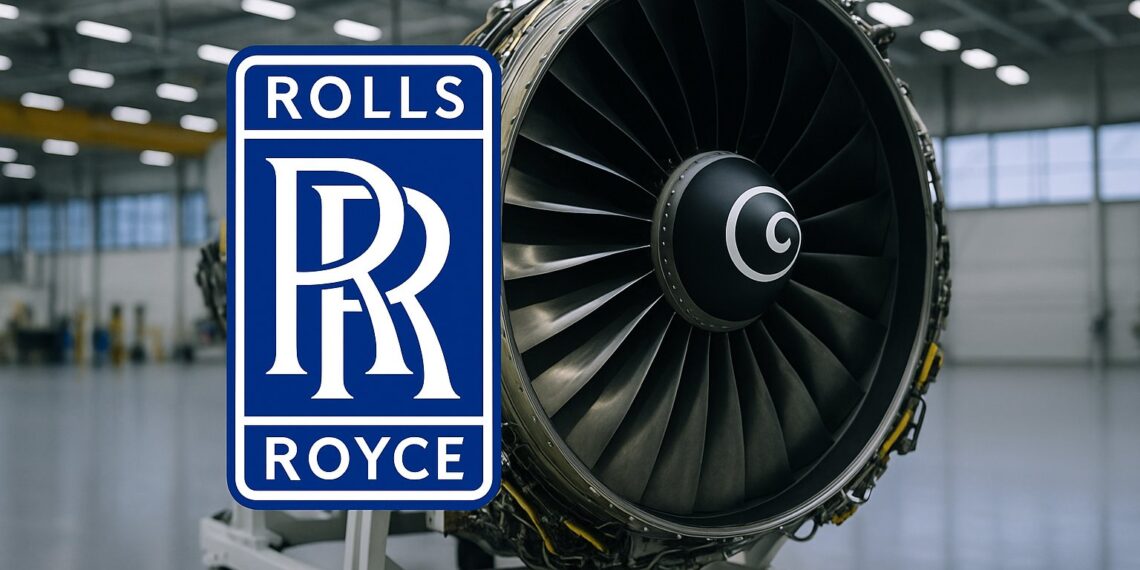Introduction: From Struggle to Strength
Few names in British industry carry as much prestige — or have endured as dramatic a turnaround — as Rolls-Royce Holdings plc.
Once weighed down by debt, cost overruns, and collapsing aviation demand, the company has staged a remarkable recovery.
In 2025, Rolls-Royce stock trades at multi-year highs, becoming one of the top-performing industrial shares in Europe. Under CEO Tufan Erginbilgiç, the company has transformed from a troubled engineering giant into a lean, cash-generating powerhouse.
After years of turbulence, Rolls-Royce is once again flying high — and investors are taking notice.
Share Price Overview: Momentum at Full Thrust
As of early October 2025, Rolls-Royce stock is trading around 1,175 pence on the London Stock Exchange — its highest level in more than a decade. The shares have more than doubled over the past twelve months, far outperforming both the FTSE 100 and the broader industrial sector.
Since the post-pandemic low near 70 pence in 2020, the stock has gained over 1,500 %. That kind of growth is rarely seen in the conservative world of British engineering.
The trajectory reflects a perfect combination of improving fundamentals, renewed investor confidence, and a global recovery in air travel.
The Three Pillars of Rolls-Royce’s Revival
The surge in Rolls-Royce stock isn’t luck — it’s the result of a disciplined, multi-year transformation plan. The company’s rebound stands on three strong pillars:
1. Aerospace Rebound
The global aviation industry has made a full comeback, and Rolls-Royce — one of the world’s leading suppliers of large jet engines — is reaping the benefits.
Orders for long-haul aircraft have surged, boosting demand for the company’s Trent engine series.
Equally important is the “Power-by-the-Hour” service model, where airlines pay for engine usage rather than upfront ownership. This approach generates recurring, high-margin revenues and gives Rolls-Royce a stable cash flow base — a key reason investors are regaining confidence.
2. Expansion in Power Systems and Defense
Beyond aviation, Rolls-Royce’s Power Systems and Defense divisions have become growth engines in their own right.
The company supplies high-efficiency propulsion systems for ships, backup generators for data centers, and advanced power solutions for military and energy clients.
As global governments boost defense budgets and industries invest in energy resilience, these segments are seeing record demand. This diversification shields Rolls-Royce from cyclical downturns in civil aviation.
3. Ruthless Cost Discipline
Since 2023, management has implemented a rigorous efficiency program. Unprofitable divisions have been sold, internal processes streamlined, and supply chains optimized.
Operating margins have surged into double digits — an extraordinary turnaround for a company that once struggled to break even.
Rolls-Royce now generates robust free cash flow and has substantially reduced net debt, restoring financial stability and investor trust.
Financial Performance: Profits Take Off
The 2025 results underline just how far Rolls-Royce has come.
Operating profit exceeds £2.5 billion, more than double the previous year, while free cash flow is comfortably above £1 billion.
For the first time since 2019, the company is generating sustainable profits across all divisions. Its strong cash position allows for strategic investment while rewarding shareholders.
Margins continue to improve thanks to disciplined contract pricing, higher engine utilization, and a more profitable mix of service revenues.
For long-term investors, this profitability marks a turning point — Rolls-Royce is no longer a recovery bet, but a renewed growth story.
Shareholder Returns: Dividend and Buyback Are Back
One of the strongest signals of confidence came when Rolls-Royce reinstated its dividend in 2025 after a five-year hiatus. Investors are receiving 6 pence per share, with management hinting at future increases as earnings expand.
At the same time, the company launched a £1 billion share buyback program — another vote of confidence in its balance sheet strength.
Together, these actions mark a milestone: Rolls-Royce has transitioned from crisis mode to capital-return mode. While the current dividend yield remains modest, investors value the consistency and predictability it represents.
Valuation: Momentum Meets High Expectations
Despite strong fundamentals, some analysts warn that Rolls-Royce stock may be priced for perfection.
The forward price-to-earnings ratio stands near 40, well above its historical average. That means investors are paying a premium for growth — and any disappointment in earnings could trigger a correction.
Still, high valuations are not unusual for companies emerging from successful turnarounds. If Rolls-Royce maintains double-digit margin growth and steady cash generation, the premium could be justified.
For now, the rally reflects faith in management execution and the long-term visibility of its order book.
Growth Drivers: Beyond Aviation
Rolls-Royce is not just riding the aviation wave; it’s positioning for the future.
The company is investing heavily in next-generation propulsion technologies, such as hydrogen-based engines and sustainable aviation fuel systems.
Another strategic initiative is its Small Modular Reactor (SMR) program — compact nuclear reactors designed to provide clean, reliable energy for industrial and regional use. If commercialized, SMRs could become a multi-billion-pound business line within the next decade.
In parallel, Rolls-Royce is expanding its digital services. Using data analytics and predictive maintenance, the company helps airlines reduce downtime, creating recurring service revenues that extend far beyond engine sales.
Risks: Why Investors Should Stay Grounded
Even great turnarounds come with turbulence. Investors should be aware of the following headwinds:
- Cyclical Exposure:
The company’s performance still depends heavily on global air traffic and new aircraft deliveries. A slowdown in travel demand or rising oil prices could dampen profits. - High Expectations:
After such a steep rally, Rolls-Royce must deliver continuous growth. Any earnings miss could spark sharp pullbacks. - Currency and Supply Chain Risks:
With most revenues earned in dollars and costs in pounds, currency fluctuations can impact earnings. Supply chain disruptions also remain a concern. - Technological Competition:
Rivals like GE Aerospace and Pratt & Whitney are investing aggressively in new propulsion technologies. Rolls-Royce must keep innovating to maintain its market share. - Dividend Fragility:
The newly reinstated dividend is symbolic but still modest. Sustaining and growing it will depend on maintaining free cash flow through economic cycles.
Investor Outlook: What Comes Next
Looking ahead, analysts expect Rolls-Royce to deliver revenue growth of 8–10 % per year through 2028, driven by engine servicing contracts, power systems, and defense programs.
Earnings per share are projected to grow even faster, thanks to higher margins and financial leverage.
If these forecasts hold, Rolls-Royce could enter a new phase of sustainable expansion — a stark contrast to its turbulent past.
At the same time, investors should be realistic. After a 1,500 % recovery, the easy gains are likely behind us. From here, performance will depend on consistent execution and innovation rather than sentiment.
Technical Picture: Strong Uptrend, Tight Range
From a technical perspective, Rolls-Royce stock remains in a clear uptrend.
The 50-day and 200-day moving averages both slope upward, confirming long-term bullish momentum.
However, the stock faces short-term resistance near 1,200 pence, while support is visible around 950 pence.
If shares consolidate within this range, it could offer patient investors an entry point before the next leg higher.
For traders, momentum indicators suggest the stock may be temporarily overbought, but long-term investors continue to favor it as a quality industrial compounder.
Long-Term Thesis: Reinvention with Global Reach
Rolls-Royce’s transformation goes beyond cost-cutting. The company has redefined itself as a diversified technology and energy player with global reach.
Its aerospace division provides steady recurring income through engine maintenance contracts.
Its defense and power systems units tap into secular trends in energy security and electrification.
And its innovation pipeline — from SMRs to hydrogen engines — positions it at the forefront of industrial sustainability.
This multi-sector model makes Rolls-Royce more resilient than ever. The company is no longer a single-cycle aviation supplier; it’s a hybrid of advanced manufacturing, energy, and digital engineering — an industrial powerhouse for the 21st century.
Scenarios for the Next Two Years
- Base Case:
Rolls-Royce continues steady growth and maintains profitability, with the stock trading between 900 – 1,300 pence. - Bull Case:
Strong demand, new contracts, and SMR progress push earnings higher, driving the stock toward 1,500 pence or more. - Bear Case:
Weaker air travel, execution issues, or macroeconomic headwinds cause a pullback to 700 – 800 pence.
The most likely path remains the base-to-bull scenario, supported by fundamentals and long-term structural demand.
Why Rolls-Royce Still Matters
Rolls-Royce is more than an engineering company — it’s a symbol of British industrial innovation.
Its resurgence is not only a financial story but also a statement about legacy brands adapting to new realities.
In an era where technology and sustainability dominate corporate strategy, Rolls-Royce is proving that even century-old manufacturers can reinvent themselves through discipline, focus, and vision.
For investors, that makes Rolls-Royce stock both a story of resilience and a bet on the future of global mobility and energy.
Conclusion: A High-Flying Blue Chip with Room to Grow
The turnaround of Rolls-Royce stock is one of the most remarkable industrial success stories of the decade.
From a near-collapse during the pandemic to record profits in 2025, the company has regained its place among Europe’s elite manufacturers.
Yes, the valuation is demanding, and the stock may pause after such a strong run.
But with robust cash flow, a reinstated dividend, and long-term structural demand for its technologies, Rolls-Royce remains a compelling investment for those seeking exposure to aerospace, energy, and industrial innovation.
The flight path is clear — Rolls-Royce has taken off again, and while turbulence is inevitable, the destination looks promising.
FAQ: Rolls-Royce Stock 2025
1. Why is Rolls-Royce stock rising so sharply?
Because the company has returned to profitability, restored its dividend, and is benefitting from strong aerospace demand and diversified growth in defense and energy systems.
2. What’s the current share price?
Around 1,175 pence, near record highs for the decade.
3. Does Rolls-Royce pay dividends again?
Yes, it reinstated a 6 pence per share dividend in 2025 and announced a £1 billion buyback.
4. What are the main risks?
High valuation, cyclical exposure to aviation, and execution risk in its transformation strategy.
5. Is Rolls-Royce stock still a buy?
For long-term investors who believe in the company’s innovation and market strength, yes — though short-term volatility and consolidation are likely.
Disclaimer
This article is for informational purposes only and does not constitute investment, financial, or trading advice. Market data and commentary reflect conditions as of October 2025 and may change without notice. Investors should perform independent analysis or consult a licensed financial advisor before making investment decisions.






